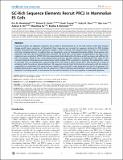GC-Rich Sequence Elements Recruit PRC2 in Mammalian ES Cells
Author(s)
Mendenhall, Eric M.; Koche, Richard Patrick; Truong, Thanh; Zhou, Vicky W.; Issac, Biju; Chi, Andrew S.; Ku, Manching; Bernstein, Bradley E.; ... Show more Show less
DownloadMendenhall-2010-GC-Rich Sequence Elements Recruit PRC2 in Mammalian ES Cells.pdf (1.214Mb)
PUBLISHER_CC
Publisher with Creative Commons License
Creative Commons Attribution
Terms of use
Metadata
Show full item recordAbstract
Polycomb proteins are epigenetic regulators that localize to developmental loci in the early embryo where they mediate lineage-specific gene repression. In Drosophila, these repressors are recruited to sequence elements by DNA binding proteins associated with Polycomb repressive complex 2 (PRC2). However, the sequences that recruit PRC2 in mammalian cells have remained obscure. To address this, we integrated a series of engineered bacterial artificial chromosomes into embryonic stem (ES) cells and examined their chromatin. We found that a 44 kb region corresponding to the Zfpm2 locus initiates de novo recruitment of PRC2. We then pinpointed a CpG island within this locus as both necessary and sufficient for PRC2 recruitment. Based on this causal demonstration and prior genomic analyses, we hypothesized that large GC-rich elements depleted of activating transcription factor motifs mediate PRC2 recruitment in mammals. We validated this model in two ways. First, we showed that a constitutively active CpG island is able to recruit PRC2 after excision of a cluster of activating motifs. Second, we showed that two 1 kb sequence intervals from the Escherichia coli genome with GC-contents comparable to a mammalian CpG island are both capable of recruiting PRC2 when integrated into the ES cell genome. Our findings demonstrate a causal role for GC-rich sequences in PRC2 recruitment and implicate a specific subset of CpG islands depleted of activating motifs as instrumental for the initial localization of this key regulator in mammalian genomes.
Date issued
2010-12Department
Harvard University--MIT Division of Health Sciences and TechnologyJournal
PLoS Genetics
Publisher
Public Library of Science
Citation
Mendenhall, Eric M. et al. “GC-Rich Sequence Elements Recruit PRC2 in Mammalian ES Cells.” Ed. Hiten D. Madhani. PLoS Genetics 6.12 (2010) : e1001244. Copyright: © 2010 Mendenhall et al.
Version: Final published version
ISSN
1553-7404
1553-7390